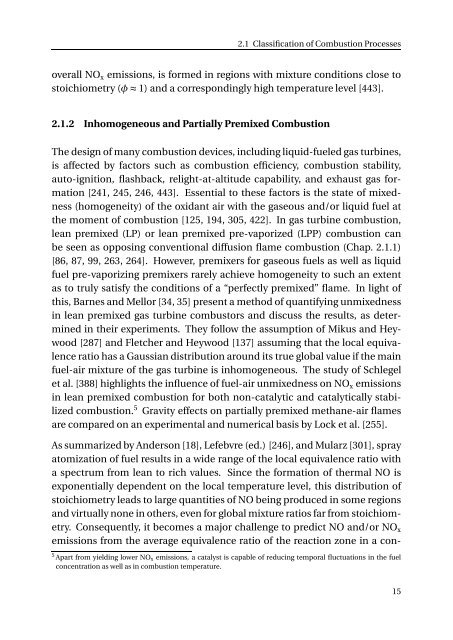On the Formation of Nitrogen Oxides During the Combustion of ...
On the Formation of Nitrogen Oxides During the Combustion of ...
On the Formation of Nitrogen Oxides During the Combustion of ...
Create successful ePaper yourself
Turn your PDF publications into a flip-book with our unique Google optimized e-Paper software.
2.1 Classification <strong>of</strong> <strong>Combustion</strong> Processes<br />
overall NO x emissions, is formed in regions with mixture conditions close to<br />
stoichiometry (φ≈1) and a correspondingly high temperature level [443].<br />
2.1.2 Inhomogeneous and Partially Premixed <strong>Combustion</strong><br />
The design <strong>of</strong> many combustion devices, including liquid-fueled gas turbines,<br />
is affected by factors such as combustion efficiency, combustion stability,<br />
auto-ignition, flashback, relight-at-altitude capability, and exhaust gas formation<br />
[241, 245, 246, 443]. Essential to <strong>the</strong>se factors is <strong>the</strong> state <strong>of</strong> mixedness<br />
(homogeneity) <strong>of</strong> <strong>the</strong> oxidant air with <strong>the</strong> gaseous and/or liquid fuel at<br />
<strong>the</strong> moment <strong>of</strong> combustion [125, 194, 305, 422]. In gas turbine combustion,<br />
lean premixed (LP) or lean premixed pre-vaporized (LPP) combustion can<br />
be seen as opposing conventional diffusion flame combustion (Chap. 2.1.1)<br />
[86, 87, 99, 263, 264]. However, premixers for gaseous fuels as well as liquid<br />
fuel pre-vaporizing premixers rarely achieve homogeneity to such an extent<br />
as to truly satisfy <strong>the</strong> conditions <strong>of</strong> a “perfectly premixed” flame. In light <strong>of</strong><br />
this, Barnes and Mellor [34, 35] present a method <strong>of</strong> quantifying unmixedness<br />
in lean premixed gas turbine combustors and discuss <strong>the</strong> results, as determined<br />
in <strong>the</strong>ir experiments. They follow <strong>the</strong> assumption <strong>of</strong> Mikus and Heywood<br />
[287] and Fletcher and Heywood [137] assuming that <strong>the</strong> local equivalence<br />
ratio has a Gaussian distribution around its true global value if <strong>the</strong> main<br />
fuel-air mixture <strong>of</strong> <strong>the</strong> gas turbine is inhomogeneous. The study <strong>of</strong> Schlegel<br />
et al. [388] highlights <strong>the</strong> influence <strong>of</strong> fuel-air unmixedness on NO x emissions<br />
in lean premixed combustion for both non-catalytic and catalytically stabilized<br />
combustion. 5 Gravity effects on partially premixed methane-air flames<br />
are compared on an experimental and numerical basis by Lock et al. [255].<br />
As summarized by Anderson [18], Lefebvre (ed.) [246], and Mularz [301], spray<br />
atomization <strong>of</strong> fuel results in a wide range <strong>of</strong> <strong>the</strong> local equivalence ratio with<br />
a spectrum from lean to rich values. Since <strong>the</strong> formation <strong>of</strong> <strong>the</strong>rmal NO is<br />
exponentially dependent on <strong>the</strong> local temperature level, this distribution <strong>of</strong><br />
stoichiometry leads to large quantities <strong>of</strong> NO being produced in some regions<br />
and virtually none in o<strong>the</strong>rs, even for global mixture ratios far from stoichiometry.<br />
Consequently, it becomes a major challenge to predict NO and/or NO x<br />
emissions from <strong>the</strong> average equivalence ratio <strong>of</strong> <strong>the</strong> reaction zone in a con-<br />
5 Apart from yielding lower NO x emissions, a catalyst is capable <strong>of</strong> reducing temporal fluctuations in <strong>the</strong> fuel<br />
concentration as well as in combustion temperature.<br />
15
















